This article has been reviewed according to Science X's editorial process and policies. Editors have highlighted the following attributes while ensuring the content's credibility:
fact-checked
proofread
New insights into the formation of tiny cloud particles in the Arctic
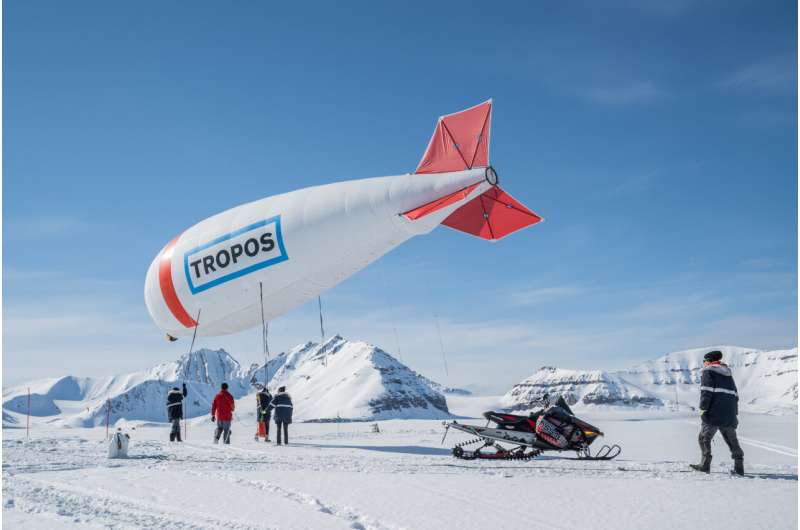
Mobile measuring devices enable the research of atmospheric processes in higher air layers that have not yet been recorded by conventional measuring stations on the ground. The airborne flight systems therefore make an important contribution to research into the causes of climate change in the Arctic.
A team of German researchers has combined two of these methods over Spitsbergen in recent weeks: Simultaneous measurements of meteorological parameters and minute aerosol particles were carried out using a tethered balloon system and an unmanned aircraft.
Several cases have already been observed in which these new formation processes took place at higher altitudes, sometimes even between cloud layers, and were therefore invisible to ground stations. These particles can, for example, influence the formation of clouds and thus have an impact on climate change. However, the reason why the Arctic is warming much faster than other regions of the world is still unclear.
In recent years, the Arctic has increasingly become the focus of climate research, as the climate changes observed to date have had a much greater impact there than in other regions. The reasons for this include complex interactions between the atmosphere, sea ice and ocean, which are difficult to quantify and model.
In order to improve our understanding of these processes and interactions, more on-site measurements are needed. Only a few continuously measuring stations and mobile measurements with ships and aircraft are available so far as a database and provide the necessary parameters for analyses and modeling.
Scientists from the Technische Universität Braunschweig (TU Braunschweig) and the Leibniz Institute for Tropospheric Research Leipzig (TROPOS) carried out measurements with an unmanned aerial system and a tethered balloon in Ny-Ålesund on Spitsbergen from mid-May to mid-June 2024. The paper is published in the journal Elem Sci Anth.
This project titled "Aerosol variability and interaction with environmental conditions based on the small-scale vertical and horizontal distribution of measurements in the Arctic" (AIDA), is primarily investigating the relationship between small-scale air movements and the formation of tiny airborne aerosol particles that can form from gases. As these small particles can continue to grow and then scatter light and contribute to the formation of clouds, they play a major role in the climate.
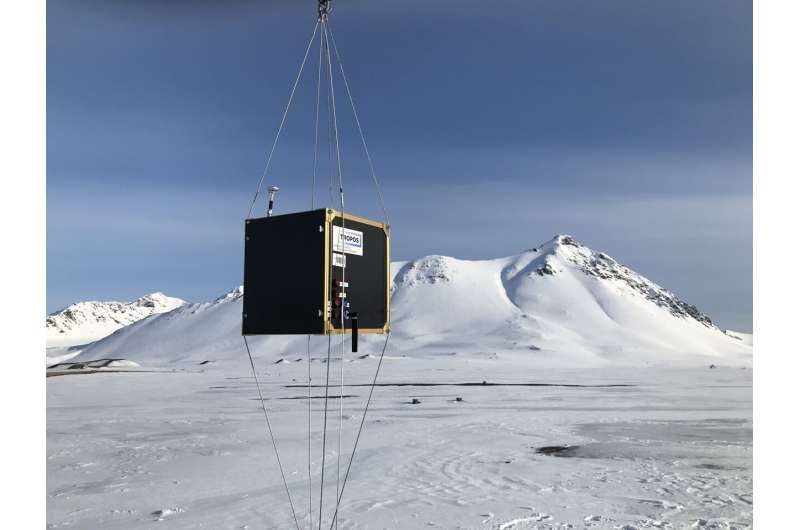
The ALADINA drone and the BELUGA balloon system were used in the project. ALADINA (Application of Light-weight Aircraft for Detecting IN-situ Aerosol) is an unmanned aircraft system (UAS) of the type "Carolo P360," which was developed at the Institute for Flight Guidance at TU Braunschweig.
It has a wingspan of 3.6 meters, weighs 25 kilograms and can carry a payload of up to 4.5 kilograms. The battery allows a flight time of up to 40 minutes and a speed of up to over 100 kilometers per hour.
The unmanned research aircraft has already been used several times, including at the TROPOS measuring station Melpitz near Torgau (Saxony), at BER Airport, in Benin in West Africa and in Spitsbergen in 2018. The special feature of this aircraft lies primarily in its equipment with particle measuring devices, which were miniaturized at TROPOS.
The balloon system BELUGA (Balloon-born moduLar Utility for profilinG the lower Atmosphere) consists of a 90 cubic meter tethered balloon that can carry a payload of up to 20 kilograms, as well as a number of measuring platforms that were specially developed for this purpose and can be used in a modular fashion.
BELUGA has already been used during several measurement campaigns in the Arctic: first in 2017 during the PASCAL Polarstern cruise, in which meteorological and turbulence parameters were initially observed.
As part of the MOSAiC drift experiment, the balloon was used for the first time in combination with the newly developed aerosol measurement platform CAMP (Cubic Aerosol Measurement Platform), as well as other payloads, including for measuring solar radiation and collecting particles on a filter for later analysis.
These various platforms were then used in a measurement campaign in Ny-Ålesund, in which balloon ascents were carried out during different seasons.
Two flight systems combined for measurement campaign for the first time
The 2024 measurement campaign follows on from a series of Arctic studies that have already been carried out with both systems individually. In the measurement campaign for the AIDA project, the systems were combined for the first time in order to determine the three-dimensional distribution of the smallest aerosol particles over the orographically inhomogeneous Kongsfjord.
While BELUGA carried out purely vertical profiles, ALADINA was able to analyze the horizontal variability at the same time. BELUGA has the advantage that it can also be operated in clouds, but it is limited to wind speeds of a maximum of 5 meters per second on the ground.
ALADINA flies under visual flight conditions, but at wind speeds of up to 15 meters per second. In total, measurements were taken with both systems in parallel on four days. In addition, each system took measurements on up to five further days.
As the two systems have different limitations in terms of measurement conditions, the combination allowed a greater number of measurement days to be covered than with either system alone. ALADINA was deployed on nine measurement days during the campaign on Spitsbergen.
This resulted in 136 profiles during 40 flights and 35 flight hours. The BELUGA tethered balloon was used for eight flight days and 90 profiles.
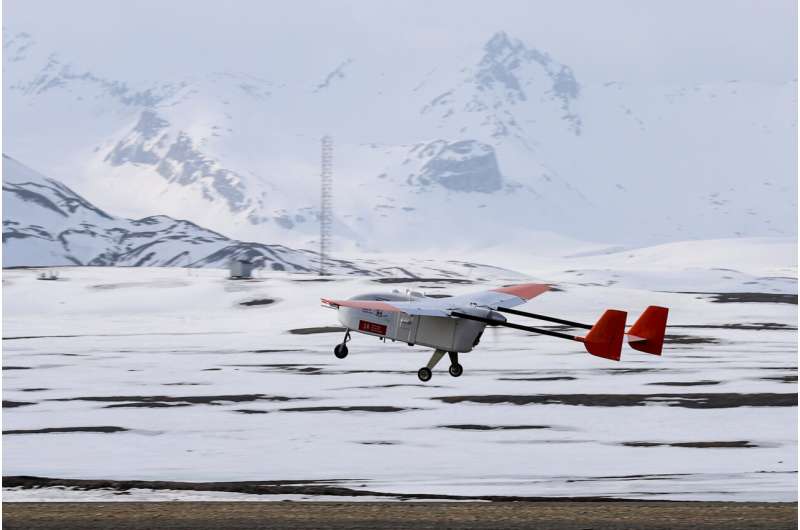
Various scenarios for new particle formation
The measurement campaign has so far shown that there are various scenarios that lead to the formation of new particles in the atmosphere:
A very interesting case was the observed formation of new particles between two cloud layers, which could be observed there with the BELUGA tethered balloon and in parallel from the observatory on the Zeppelin mountain. This layer of tiny aerosol particles slowly descended after the clouds had dispersed and could be detected on the ground at the end of the day.
ALADINA was also able to record a day on which extremely high concentrations of the small particles occurred in all layers, even beyond the Zeppelin mountain up to 900 meters. This phenomenon was observed at very high wind speeds and with high variability of the particles in the horizontal dispersion over the Kongsfjord.
-
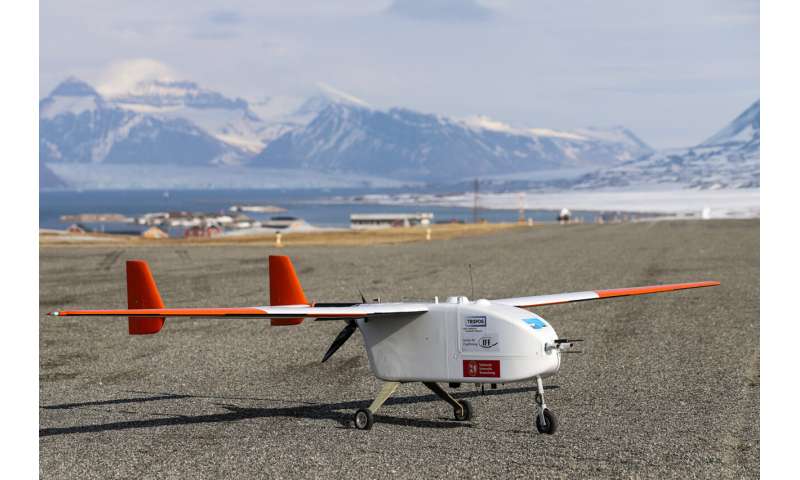
The unmanned research aircraft ALADINA before the next measurement flight. The research village of Ny-Ålesund can be seen in the background. Credit: Lutz Bretschneider, TU Braunschweig -
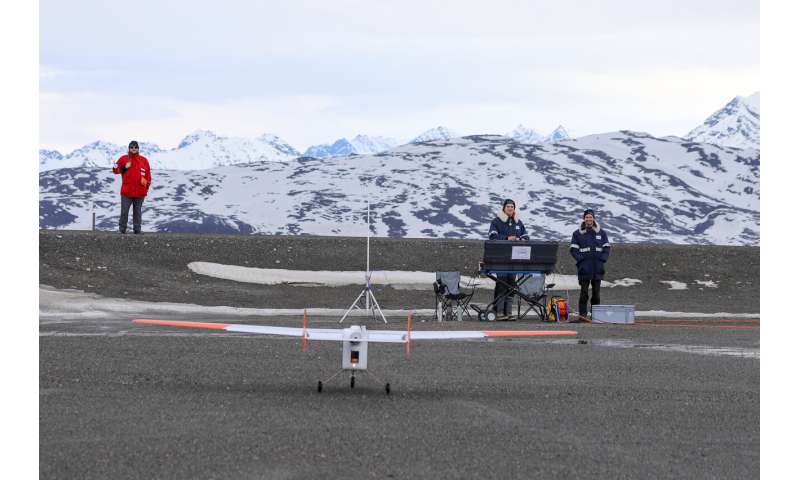
The unmanned research aircraft ALADINA after landing. In the background are employees of TU Braunschweig and TROPOS at the ground station. Credit: Barbara Harm-Altstädter, TU Braunschwei
Both teams were thus able to observe a variety of phenomena that were new compared to previous campaigns. The very rapid progression of snowmelt and the subsequent start of plant growth in particular appear to be driving the phenomenon of new particle formation very strongly.
In order to understand the various processes that can lead to the formation of new particles, a detailed analysis of the measurement data is necessary, which will keep the scientists busy over the next few months.
More information: Christian Pilz et al, Tethered balloon measurements reveal enhanced aerosol occurrence aloft interacting with Arctic low-level clouds, Elem Sci Anth (2024). DOI: 10.1525/elementa.2023.00120
Provided by Leibniz Institute for Tropospheric Research (TROPOS)





















